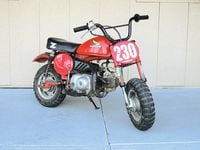Every so often a motorcycle comes along that, for one reason or another, resonates with riders. It becomes a sudden smash hit, exceeding expectations and selling so rapidly that dealerships have to dust off the waiting list.
Honda’s Grom is one of those bikes.
Its approachable size and playful styling attract people like a floppy-tailed puppy. “Everyone likes them,” says Gene Booth, sales manager at Huntington Beach Honda in Huntington Beach, California (a.k.a. Surf City), home to the salty-haired youths that give the Grom its name. “There is no niche or specific demographic for this bike. Old riders, new riders, guys and girls—they all love it.” Honda built the Grom for newbs, but the little bike’s appeal is nearly universal, and its popularity has risen to a fever pitch. “As soon as Honda announced the bike, we had a waiting list of over 70 people,” Booth says.
In a world so focused on performance and technology, it’s ironic that there’s nothing mechanically special about the Grom. Its 125cc, SOHC engine is about as technologically advanced as what you’d find in a log-splitter, and the basic design is ancient in motorcycling terms; it dates back to the original minibike, Honda’s Z50 Mini Trail of the late ’60s. But the Grom’s edgy styling and affordable price are getting people excited. Really excited.
For example, you can easily double the cost of your $3,199 Grom with an assortment of accessories, as powerhouse aftermarket manufacturer Yoshimura R&D has done with the two Groms shown here. These bling-laden playbikes might make you shake your head in wonder and disbelief, but the fact remains that Yosh, among others, is simply reacting to demand. Companies keep their ears to the ground listening for just the sort of buzz that surrounds the Grom, and they’re responding to the excitement.
Outfitted with Yoshimura exhausts, Race Tech and Öhlins suspension components, Galfer brake discs and lines, and even a Bazzaz fuel controller and Yoshimura race cam from Japan, these two bikes are prime examples of the sort of modifications owners can make to their Groms. “The bike’s price is one of the keys to its popularity,” Race Tech’s Chris Riesenberg says, “but it also means that some components are subpar. The good news is, it’s a low barrier to enter, and once in, owners are up for spending money on upgrades.” Indeed, there was so much interest in suspension that Race Tech now offers six different shock options as well as numerous fork components for the Grom.
With ample seat time on a stock Grom (it’s perfect for running errands or going out to grab lunch, and it makes a great pitbike at the track), I was pretty impressed with how much better Yoshimura’s modded Groms work, especially the red bike. With its full race exhaust, race cam, and fuel controller, throttle response is snappy and power output is significantly stronger than stock—which means this hotted-up bike can actually get out of its own way. Race Tech components front and rear keep the suspension from bottoming, encouraging you to brake and turn harder and maybe jump the occasional curb. As equipped, the bike accelerates, turns, and stops much better than a stock bike, which means you can ride it harder and have more fun.
And fun is what it all comes down to. From riding to modifying to interacting with other Grom owners via forums and group events, the Grom is creating its own vigorous, multifaceted subculture (see following pages). Grom fever will surely ebb over time, but there’s no doubt the bike will remain popular for years to come.
ROADRACING
Introducing Riders to Their M1 and Their Amateur Racing Licenses at the Same Time
When Honda discontinued its NSR50 and RS125 two-stroke roadracers in the mid 2000s, it removed the bottom two rungs from the ladder that many youths used as an entryway into roadracing. Those simple two-strokes were also popular with adults who favored affordability and fun over four-digit tire budgets and breakneck speeds.
Although the Grom is no replacement for those purpose-built roadracers, the bike has been adopted by mini-racing organizations such as Southern California’s M1GP (m1-grandprix.com), where it is helping to fill a need for affordable, durable, pint-size track bikes.
“The Grom is great news for the sport,” M1GP Director Young Lee says. “There’s a general excitement surrounding the bike, so we made a class for it, and that interest has definitely carried over to racing.”
The little Honda is easy on gas, easy on tires, crashes well, and makes for a fun and effective means to master racing basics. “It’s certainly not a fast bike, but on a kart track it’s a lot of fun, and it’s easy to push the bike to its limit,” reports Roderic Saito, who raced a Grom in M1GP’s annual 24-hour endurance race last September.
Honda expected the Grom to serve as an entry-level bike for street riders, but its designers probably weren’t expecting to introduce anyone to roadracing. But with M1GP and other mini-racing clubs, that’s exactly what the Grom is doing.
CUSTOMIZING
Stretched, Slammed, and So, So, Sick!
Honda’s small-bore bikes have long been popular candidates for customization, and the Grom is no different. Individual owners and speed shops around the world are adopting the Grom as a pet project and creating some truly incredible (and often outlandish) customs in the process.
Aftermarket support is fueling the fire. “Companies all over the US are making parts, from swingarm kits to machined-aluminum wheels,” says Edward Perez of VRaceWorks (vraceworks.com) in Brooklyn, New York, a four-wheel speed shop that has recently created a two-wheel division in response to interest in the Grom.
In Thailand, the Grom’s country of origin, the little Honda has spawned a lucrative accessory aftermarket. “There are shops in Thailand that specialize solely in Grom accessories, and they’re doing quite well,” says Nerath Khat, a Denver-based entrepreneur who’s creating his own company, GoGrom (gogrom.com), importing Grom parts and accessories from Thailand.
Not surprisingly, the most ardent Grom customizers are former Honda Ruckus owners, individuals renowned for their desire to modify their rides. “The Ruckus paved the way for the Grom as a custom,” says Two-Wheel Media Coordinator for Honda North America Tony Defranze. “The Ruckus fad died down a few years ago, so those guys have been looking for something new to work on. The Grom filled the void perfectly.”
Lengthened and lowered (or “stretched and slammed”) Groms are popular, but rat bikes, café racers, and replica builds are also prevalent. The most impressive custom we’ve seen is the beautiful Repsol-themed bike pictured above. With a single-sided swingarm, widened wheels, dry clutch, oil cooler, dual-disc front brake, Öhlins fork, and custom bodywork, the cost of this incredible custom from Thailand likely rivals that of the Ducati Monster it appears to have been modeled after.
Interestingly, most customizers focus only on the Grom’s aesthetic, choosing to leave the anemic motor alone. There are, however, some Groms out there inhaling nitrous oxide with their intake charge, and just recently we got wind of a build that involves shoehorning a race-spec CRF450X motor into the diminutive Grom’s frame. Ironically, that bike doesn’t have an extended swingarm!
STUNTING
Tilting it to 12 O’Clock With Just 9 hp
Stunting on the anemic little Grom isn’t particularly popular in America (it is among certain members of the Motorcyclist staff, however—more on that in a minute), but in Asia, where bikes are small and space is limited, Honda’s little four-speed stud has become the top choice for those looking to breakdance on two wheels.
Where the majority of motor-driven cycles are centrifugal-clutched scooters, a manual-transmission motorcycle with a short wheelbase is bound to find favor among anyone trying to pop a wheelie. “The fact that this bike has a hand clutch and foot brake makes it good for stunting, and parts are very cheap when we break them!” Thai Dark Knight Street rider Cholladhii Kaewmol says.
In Thailand the Grom dominates stunt competitions, which attract dozens of competitors and hundreds of spectators. The stunt scene has become important enough that Honda Motor Company Asia flew American pro stunter Nick “Apex” Brocha all the way to Bangkok to film a promo vid of him wheelying and endoing the feisty little Honda. Needless to say, Nick now enjoys celebrity status in Thailand.
Inspired by Nick’s video and our own desire to do silly things on small bikes, Associate Editor Zack Courts and I pulled on our leathers and put together our own stunt video.
HONDA’S OTHER CULT MINIS
It’s only been around for two years, but it’s safe to say Honda has created a cult bike in the Grom. Another cult bike, that is. Something about Honda’s minibikes captures the hearts and imaginations of the masses, and for a few folks on the fringes of motorcycling, these bikes can become an obsession. Here are a few other small-bore Hondas that have prompted people to go off the deep end.
Z50 Mini Trail
Honda’s most memorable minibike, the Z50 Mini Trail, debuted in 1968. The little Z is responsible for introducing tens of thousands of people to motorized two-wheeled travel, and it’s still a popular beginner’s bike. The Mini Trail’s raw nostalgic value has made it a collector’s item, with early, pristine examples bringing top dollar.
CRF50
The CRF50 picked up where the legendary Z50 left off and spawned an era of adult mini-motocross racing, indoor minimoto, and stunting. With adults in the saddle some modifications were necessary, but many folks took it to the extreme. Big-bores, billet frames, disc brakes, and $1,000 upside-down forks were the norm during the CRF50’s heyday.
RUCKUS
The original Ruckus first appeared in late 2002, but it took a few years to catch on. The rugged-looking 49cc scooter alternative quickly gained popularity, especially in a subset of committed customizers who stretched, slammed, and candy-coated the bikes to levels typically reserved for show-grade Hayabusas and choppers.





























/cloudfront-us-east-1.images.arcpublishing.com/octane/U4I7G625B5DMLF2DVIJDFZVV6M.jpg)
/cloudfront-us-east-1.images.arcpublishing.com/octane/B6XD6LS6IVCQPIU6HXDJSM3FHY.jpg)
/cloudfront-us-east-1.images.arcpublishing.com/octane/ICL63FEDDRDTTMINYICCEYGMDA.jpg)
/cloudfront-us-east-1.images.arcpublishing.com/octane/FCGZHQXRBZFLBAPC5SDIQLVF4I.jpg)
/cloudfront-us-east-1.images.arcpublishing.com/octane/WNOB6LDOIFFHJKPSVIWDYUGOPM.jpg)

/cloudfront-us-east-1.images.arcpublishing.com/octane/X33NU3E525ECRHXLNUJN2FTRKI.jpg)
/cloudfront-us-east-1.images.arcpublishing.com/octane/6KKT5NNL2JAVBOXMZYS5ZO76YA.jpg)
/cloudfront-us-east-1.images.arcpublishing.com/octane/J5RKG5O455GMPGQRF2OG6LRT7A.jpg)
/cloudfront-us-east-1.images.arcpublishing.com/octane/GX2CIZKQVRH2TATDM26KFG2DAE.jpg)
/cloudfront-us-east-1.images.arcpublishing.com/octane/ZWIDYSAKQZHD5BHREMQILXJCGM.jpg)
/cloudfront-us-east-1.images.arcpublishing.com/octane/CYUHJZCTSJCH3MRAQEIKXK7SCQ.jpg)
/cloudfront-us-east-1.images.arcpublishing.com/octane/LKOFINY56FCXJCANJ5M7ZDQUBY.jpg)
/cloudfront-us-east-1.images.arcpublishing.com/octane/4NBPDACMWJH63JQYJVK3QRBDZI.jpg)
/cloudfront-us-east-1.images.arcpublishing.com/octane/KKHQHRR3FJGX7H2IPU6RALMWG4.jpg)

/cloudfront-us-east-1.images.arcpublishing.com/octane/5IOFS5JAE5FOXMNA23ZRAVVYUU.jpg)
/cloudfront-us-east-1.images.arcpublishing.com/octane/CGXQ3O2VVJF7PGTYR3QICTLDLM.jpg)

/cloudfront-us-east-1.images.arcpublishing.com/octane/OQVCJOABCFC5NBEF2KIGRCV3XA.jpg)
/cloudfront-us-east-1.images.arcpublishing.com/octane/OPVQ7R4EFNCLRDPSQT4FBZCS2A.jpg)
/cloudfront-us-east-1.images.arcpublishing.com/octane/YBPFZBTAS5FJJBKOWC57QGEFDM.jpg)
/cloudfront-us-east-1.images.arcpublishing.com/octane/W5DVCJVUQVHZTN2DNYLI2UYW5U.jpg)
/cloudfront-us-east-1.images.arcpublishing.com/octane/C3VIRIAYNZCTJAZNRLREDS3JCM.jpg)